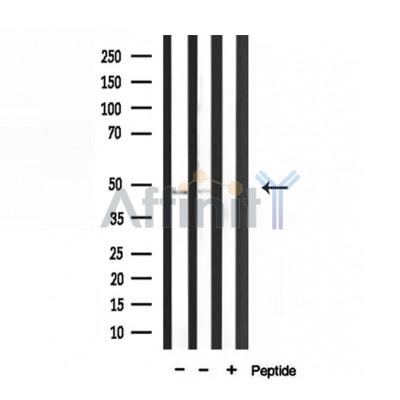ACAT1 Antibody - #DF3726
| Product: | ACAT1 Antibody |
| Catalog: | DF3726 |
| Description: | Rabbit polyclonal antibody to ACAT1 |
| Application: | WB IHC IF/ICC |
| Reactivity: | Human, Mouse, Rat |
| Prediction: | Zebrafish, Bovine, Horse, Sheep, Rabbit, Dog, Chicken |
| Mol.Wt.: | 45 KD; 45kD(Calculated). |
| Uniprot: | P24752 |
| RRID: | AB_2836090 |
Related Downloads
Protocols
Product Info
*The optimal dilutions should be determined by the end user. For optimal experimental results, antibody reuse is not recommended.
*Tips:
WB: For western blot detection of denatured protein samples. IHC: For immunohistochemical detection of paraffin sections (IHC-p) or frozen sections (IHC-f) of tissue samples. IF/ICC: For immunofluorescence detection of cell samples. ELISA(peptide): For ELISA detection of antigenic peptide.
Cite Format: Affinity Biosciences Cat# DF3726, RRID:AB_2836090.
Fold/Unfold
ACAT 1; ACAT; acat1; Acetoacetyl CoA thiolase; acetoacetyl Coenzyme A thiolase; Acetoacetyl-CoA thiolase; Acetyl CoA acetyltransferase, mitochondrial; Acetyl Coenzyme A acetyltransferase 1; Acetyl-CoA acetyltransferase; acetyl-coa acetyltransferase precursor, mitochondrial; Acetyl-CoA thiolase, mitochondrial; acetyl-Coenzyme A acetyltransferase 1; MAT; mitochondrial acetoacetyl-CoA thiolase; mitochondrial; RATACAL; T2; testicular tissue protein Li 198; THIL; THIL_HUMAN;
Immunogens
A synthesized peptide derived from human ACAT1, corresponding to a region within the internal amino acids.
- P24752 THIL_HUMAN:
- Protein BLAST With
- NCBI/
- ExPASy/
- Uniprot
MAVLAALLRSGARSRSPLLRRLVQEIRYVERSYVSKPTLKEVVIVSATRTPIGSFLGSLSLLPATKLGSIAIQGAIEKAGIPKEEVKEAYMGNVLQGGEGQAPTRQAVLGAGLPISTPCTTINKVCASGMKAIMMASQSLMCGHQDVMVAGGMESMSNVPYVMNRGSTPYGGVKLEDLIVKDGLTDVYNKIHMGSCAENTAKKLNIARNEQDAYAINSYTRSKAAWEAGKFGNEVIPVTVTVKGQPDVVVKEDEEYKRVDFSKVPKLKTVFQKENGTVTAANASTLNDGAAALVLMTADAAKRLNVTPLARIVAFADAAVEPIDFPIAPVYAASMVLKDVGLKKEDIAMWEVNEAFSLVVLANIKMLEIDPQKVNINGGAVSLGHPIGMSGARIVGHLTHALKQGEYGLASICNGGGGASAMLIQKL
Predictions
Score>80(red) has high confidence and is suggested to be used for WB detection. *The prediction model is mainly based on the alignment of immunogen sequences, the results are for reference only, not as the basis of quality assurance.
High(score>80) Medium(80>score>50) Low(score<50) No confidence
Research Backgrounds
This is one of the enzymes that catalyzes the last step of the mitochondrial beta-oxidation pathway, an aerobic process breaking down fatty acids into acetyl-CoA. Using free coenzyme A/CoA, catalyzes the thiolytic cleavage of medium- to long-chain 3-oxoacyl-CoAs into acetyl-CoA and a fatty acyl-CoA shortened by two carbon atoms. The activity of the enzyme is reversible and it can also catalyze the condensation of two acetyl-CoA molecules into acetoacetyl-CoA. Thereby, it plays a major role in ketone body metabolism.
Succinylation at Lys-268, adjacent to a coenzyme A binding site. Desuccinylated by SIRT5 (By similarity).
Mitochondrion.
Belongs to the thiolase-like superfamily. Thiolase family.
Research Fields
· Metabolism > Lipid metabolism > Fatty acid degradation.
· Metabolism > Lipid metabolism > Synthesis and degradation of ketone bodies.
· Metabolism > Amino acid metabolism > Valine, leucine and isoleucine degradation.
· Metabolism > Amino acid metabolism > Lysine degradation.
· Metabolism > Amino acid metabolism > Tryptophan metabolism.
· Metabolism > Carbohydrate metabolism > Pyruvate metabolism.
· Metabolism > Carbohydrate metabolism > Glyoxylate and dicarboxylate metabolism.
· Metabolism > Carbohydrate metabolism > Propanoate metabolism.
· Metabolism > Carbohydrate metabolism > Butanoate metabolism.
· Metabolism > Metabolism of terpenoids and polyketides > Terpenoid backbone biosynthesis.
· Metabolism > Global and overview maps > Metabolic pathways.
· Metabolism > Global and overview maps > Carbon metabolism.
· Metabolism > Global and overview maps > Fatty acid metabolism.
Restrictive clause
Affinity Biosciences tests all products strictly. Citations are provided as a resource for additional applications that have not been validated by Affinity Biosciences. Please choose the appropriate format for each application and consult Materials and Methods sections for additional details about the use of any product in these publications.
For Research Use Only.
Not for use in diagnostic or therapeutic procedures. Not for resale. Not for distribution without written consent. Affinity Biosciences will not be held responsible for patent infringement or other violations that may occur with the use of our products. Affinity Biosciences, Affinity Biosciences Logo and all other trademarks are the property of Affinity Biosciences LTD.


